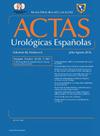Análisis de la supervivencia del dispositivo y los factores predictivos de la misma en una cohorte de pacientes intervenidos de esfínter urinario artificial masculino
IF 1.2
4区 医学
Q3 UROLOGY & NEPHROLOGY
引用次数: 0
Abstract
Introduction
Stress urinary incontinence (SUI) affects between 2.5% and 40% of patients after radical prostatectomy. Although the implantation of an artificial urinary sphincter (AUS) offers continence rates of 70-80%, its failure rate reaches 25% in some series. This single-center retrospective study analyzed the survival of AUS and the factors associated with its failure.
Materials and methods
A total of 145 patients treated with the AMS 800® device (Boston Scientific) between 2010 and 2023 were included. Kaplan-Meier analysis and the Cox proportional hazards model were used to evaluate device survival and identify predictive factors for failure.
Results
The mean age was 68.6 years; 28% of patients were smokers, 43.7% had diabetes, and 26.2% had undergone prior radiation therapy. Radical prostatectomy was the main cause of SUI (86.9%). In the majority of cases (91.5%), the artificial urinary sphincter was implanted around the bulbar urethra. During follow-up, 25.5% of patients required revision surgery. The probability of functional sphincter survival was 89% at 1 year, 78% at 2 years, 64% at 5 years, and 51% at 10 years. On multivariate analysis, prior radiation therapy (HR: 2.06; P=.029) and diabetes (HR: 2.24; P=.04]) were associated with poorer device survival.
Conclusions
The AUS is an effective and safe treatment for severe SUI, although radiotherapy and diabetes may adversely affect its durability.
男性人工尿道括面肌组患者存活率和预测因素分析
导读:压力性尿失禁(SUI)在根治性前列腺切除术后的发生率为2.5% - 40%。虽然人工尿道括约肌(AUS)植入术的失禁率为70-80%,但在某些系列中其失败率达到25%。这项单中心回顾性研究分析了AUS的生存率及其失败的相关因素。材料和方法在2010年至2023年期间,共纳入145例使用AMS 800®设备(波士顿科学公司)治疗的患者。Kaplan-Meier分析和Cox比例风险模型用于评估器械存活率和确定失效的预测因素。结果患者平均年龄68.6岁;28%的患者为吸烟者,43.7%的患者患有糖尿病,26.2%的患者既往接受过放疗。根治性前列腺切除术是SUI的主要原因(86.9%)。大多数病例(91.5%)在球尿道周围植入人工尿道括约肌。随访期间,25.5%的患者需要翻修手术。功能性括约肌存活的概率为1年89%,2年78%,5年64%,10年51%。多因素分析显示,既往放射治疗(HR: 2.06;P= 0.029)和糖尿病(HR: 2.24;P=.04])与较差的器械存活率相关。结论AUS是一种安全有效的治疗重度SUI的方法,但放疗和糖尿病可能会影响其耐久性。
本文章由计算机程序翻译,如有差异,请以英文原文为准。
求助全文
约1分钟内获得全文
求助全文
来源期刊

Actas urologicas espanolas
UROLOGY & NEPHROLOGY-
CiteScore
1.90
自引率
0.00%
发文量
98
审稿时长
46 days
期刊介绍:
Actas Urológicas Españolas is an international journal dedicated to urological diseases and renal transplant. It has been the official publication of the Spanish Urology Association since 1974 and of the American Urology Confederation since 2008. Its articles cover all aspects related to urology.
Actas Urológicas Españolas, governed by the peer review system (double blinded), is published online in Spanish and English. Consequently, manuscripts may be sent in Spanish or English and bidirectional free cost translation will be provided.
 求助内容:
求助内容: 应助结果提醒方式:
应助结果提醒方式:


